BY THOMAS JACKSON
The outside ventilation (OV) firefighter is often an underused and unassigned position in a lot of smaller, often understaffed departments. This beneficial position is often misunderstood. Below, I will focus mainly on the OV firefighter operating at one- and two-family dwellings.
To some officers, the OV firefighter is considered a freelance position. This couldn’t be further from the truth. It is not freelancing when the OV is following the assigned tasks with the knowledge and direction of the ladder company officer. Communication between the OV, the interior ladder officer, and the incident commander (IC) must be emphasized.
OUTSIDE VENT SOGs
An OV must complete specific tasks. Standard operating guidelines (SOGs) detailing what is expected from this position will dispel this misconception of freelancing. Company officers should review, train on, and enforce this SOG. An experienced firefighter with sound training and solid procedures in this position will prove extremely beneficial on structure fires. In situations in which there are no experienced firefighters, a firefighter must still be assigned to these critical OV duties and, if possible, be supported by another firefighter.
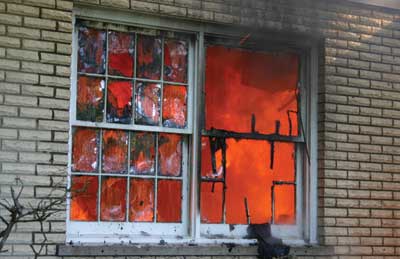 |
| (1) During the 360°, if the window has failed already, the OV firefighter should not take out the remainder of the window until the handline is in place. [Photos courtesy of the Forest Park (OH) Fire Department.] |
THE 360° SURVEY
The OV firefighter assists the interior crews by searching for the fire; providing coordinated horizontal ventilation of the fire room or rooms; and, in some instances, performing vent-enter-search (VES) tactics. The OV also performs the 360° survey of the fire building and reports back to the interior officer and IC. During the 360° survey, the OV reports any obvious signs of fire-e.g., fire showing from a rear window-and any smoke, carefully noting its color, volume, density, and velocity.
Is “black fire” showing from a window or a doorway? This dense, high-volume, turbulent, churning black smoke is a sign of impending flashover; there will be no survivors in this area. Black fire temperatures will be high enough to do the same physical damage as the fire itself. Combat a black fire situation through proper recognition, venting, and cooling with an appropriate size handline.
If nothing is showing, report this as well. Does the building have any setbacks or extensions? This could mean it has two separate roofs. Where do security bars need to be removed? What other hazards exist that are not visible from the front? Are any victims showing from windows, and are resources such as ladders needed?
The OV should communicate by radio to ensure that everyone on the fireground is informed. If radio traffic is heavy and there seems to be no break to allow the OV to get his message out to command, he may need to use the word “urgent” to gain radio control and broadcast his information. If the OV sees victims trapped or in a window, he may need to use the words “emergency traffic.” In addition, if the fire has progressed so rapidly and severely deteriorated the structure, the OV firefighter may have to announce a “Mayday” for an imminent collapse hazard.
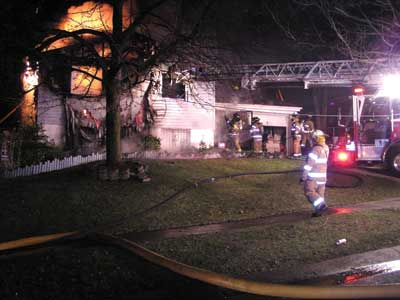 |
| (2) The OV looks for and reports obstructions that will impede escaping firefighters, such as trees, power lines, and burglar bars. |
ASSIGNING AN OV FIREFIGHTER
The OV member is traditionally a part of a ladder company but need not be on a ladder company to be effective. The IC should ensure that an OV firefighter is set up at every structure fire response. With different staffing levels across the country, it may not be easy to provide an OV position on the fireground, but it should be a priority. If a building is set back from the roadway or numerous wires and trees limit aerial or tower ladder access, the ladder company driver can act as the OV. If your department does not have a ladder apparatus, an incoming engine company member could be the designated OV. In these situations, deploy a second OV as soon as possible to work with the first OV as a team. Since today’s fires are growing at a faster rate and burning at higher temperatures, firefighters are now arriving at structure fires at a point that is much nearer to or even at the point of flashover.
The OV position summary below focuses on single-family residential fires and discusses the position’s role, duties, and tool selection. Assign an OV at the beginning of the shift or immediately on arrival at a working incident.
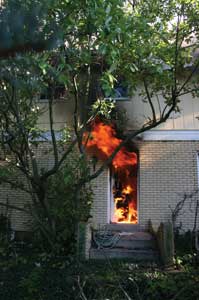 |
| (3) If possible and if the door is still intact, an OV should attempt to use the hook to close the door to limit ventilation until the handline is in place. At that point, the door can be opened for coordinated ventilation. |
QUALIFICATIONS
The OV must have a sound understanding of smoke and fire behavior and building construction; a good amount of experience; and, most importantly, discipline. Discipline originates from the company officers and senior firefighters who explain what they expect from the OV, the assigned firefighter’s experience, and strong training habits. The OV firefighter must be experienced enough to know how his actions will affect not only the interior crews but also the spread of fire to other exposures. The OV will often be in positions in which he will have to make split-second decisions alone. This firefighter must know the outcome of his actions. Above all, based on his own training and experience, the OV should have the confidence to complete the tasks assigned to him.
The OV should also have the confidence of the ladder officer. To gain this, the OV should be self-motivated enough to ask the officer his expectations when the shift begins and discuss his job tasks with the officer. If this is done at the beginning of the shift, it will ensure that the company officer, the OV firefighter, and the rest of the crew know what to expect from the OV position. It also allows the officer an opportunity to correct any misconceptions and discuss any task with the crew.
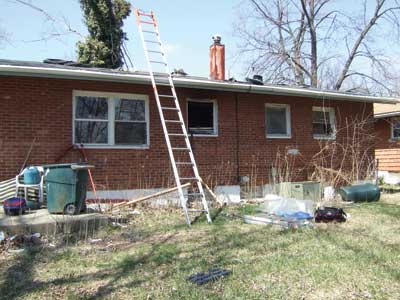 |
| Arriving at the rear of the building, the OV placed a ladder to provide a secondary means of egress from the roof and coordinated ventilation. |
TOOLS AND THE 360°
For a residential fire, the OV firefighter should be equipped with the following tools at a minimum: full personal protective equipment; self-contained breathing apparatus; a six-foot hook; a halligan; a flashlight; a radio; a ground ladder appropriate for addressing the type, size, or special features of the building (e.g., high ranch windows, contemporary construction); and a thermal imaging camera (TIC), if available.
The OV is assigned to the 360° survey and, most importantly, the rear of the building. The OV should notify command if obstacles will delay the 360°, such as privacy fences, trees, and so forth. The OV relays all findings to the ladder officer and the IC to assist the interior crews in finding the fire. The OV should focus on smoke and fire conditions. Indicators of the fire’s location include failing windows with fire showing behind and heavier smoke or fire coming from one or more windows.
The OV should describe what he sees and where it is on the 360°-e.g., fire showing from the second floor near the B/C corner, smoke issuing from the attic A/B corner, people hanging from windows on the second-floor C/D corner, or a victim waving from a window in the attic on the C side. As he does his 360°, the OV should look for utilities and also any victims who might have jumped prior to fire department arrival.
The OV should also ensure that the basement is clear and, if any basement windows are open, should try to shut them to control air flow and the fire. If you break the window, you have no way to control the environment. Pay attention to the wind direction and conditions to ensure you do not allow the wind to push the fire back over the attack crews or up a “chimney” that the attack crew may be using to descend into the fire area. After the attack crew is in place, then the window can be vented for coordinated ventilation. By doing this survey, the OV can ensure that the interior crews are not working over an unchecked fire.
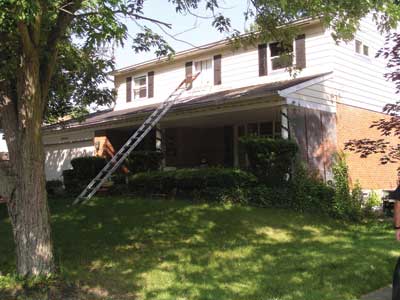 |
| (5) A front porch overhang can offer quick access to multiple bedrooms for a VES operation. |
BASEMENT FIRES
Basement fires present several hazards, including limited access, storage items of unknown type and quantity, and limited ventilation. Having an OV force the basement door or notify command of a walk-out basement can make for a safer attack on a basement fire. The OV can monitor basement fire conditions from a basement door or window. From this vantage point, this firefighter may also give the IC a size-up of the type of construction supporting the floor and note whether a gypsum board ceiling is in place protecting the structural members. The windows will be the main ventilation point for a basement fire. The OV will be in a good position to take the windows for ventilation purposes. Coordinating ventilation should still be a priority. Prematurely venting the windows can cause the fire to accelerate. Before venting, crews must be in place with a charged handline ready to attack the fire. Notifying the engine company that a basement door exists will prevent the crew from crawling over a lightweight truss system in the floor that is subject to early failure. In addition, knowing that an exterior basement access exists, the crew can avoid taking a beating in trying to access the basement down a narrow stairway that is a flue for escaping heat, gases, and smoke.
CONTROLLING UTILITIES AND OTHER HAZARDS
Finding and securing the utilities is an OV task that also assists fire containment. Shutting down the utilities can aid extinguishment for fires starting or involving the natural gas lines or electric boxes. Utility control also assists in searching for fire extension. Cutting the building’s electricity supply helps ensure that overhaul firefighters using metal hooks do not hit energized wires and suffer electric shock.
Other possible firefighter hazards the OV should look for include aggressive animals in the rear, snow-covered swimming pools, and burglar bars, which should be removed manually or by using a saw. If the OV has initiated removing the bars, he should relay this to the IC, because it might delay fulfillment of other OV functions, which may need to be reassigned. Remember, while removing bars from the windows, notify the interior crews where windows offering unimpeded access are for a secondary means of egress.
With fire on the first floor or in the basement, the OV should force the back door if wind conditions are not pushing into the structure, do a quick sweep with a hand tool or TIC, and then close the door. Since most first-floor fires occur in or near the kitchen and the back door is close to the kitchen, it is usually a great starting position for ventilation. Closing the door helps keep the ventilation timed and coordinated. If the back door is left open without a handline in place, this gives the fire time to grow and extend to other areas of the building.
At a single-story structure, if the OV isn’t preoccupied with other duties on arrival, he may be able to place a ladder to the roof as a secondary means of egress. Remember, some ranch dwellings have high ranch windows to rooms, which may necessitate use of a smaller ladder-e.g., an A-frame, the little giant for access/egress. Usually, the roof team throws the ladder for its own access while the OV performs his tasks.
For a fire involving a two-story residential dwelling, the OV must make some quick decisions. If people need immediate rescue, use the ladder to facilitate a rescue. If no victims are in immediate need of assistance, the OV should attempt to get into position to ventilate the fire room. If the fire is on the first floor, the OV can place the ladder to a second-floor window for the interior search team as a secondary means of egress.
VENTILATION TIMING
The following signs will indicate to the OV when to ventilate the fire room:
- The interior crew reports on the radio that it has made it to the fire.
- The fire room is emitting steam.
- The handline is heard working in the fire room.
- Direct communication from an engine company officer who announces the crew is beginning the fire attack.
Coordinating ventilation between the OV and attack crew is crucial. Taking the windows to the fire room too early may lead to heavier and hotter fire conditions. Fire venting from a window with no attack team in place may spread through autoexposure. The OV firefighter should pay attention to houses that sit close to an exposure building. He, again, must be disciplined enough to get into position and wait until the attack crew is ready and prepared to make an attack prior to venting. The initial horizontal ventilation should start as close as possible to the origin of the fire and opposite the handline. Since most fire attacks are started from the front door, assigning the OV to the building’s C side usually offers a prime spot to start ventilation. The initial ventilation should never be behind the attack crews, since this can pull the fire over the top of the attack line.
Remember, any opening put into the building is a ventilation point-e.g., an open front door. The OV has to get opposite the handline and make an opening for the steam to be “pushed” toward. If the ventilation opening is not in front of the handline, meaning the only ventilation opening is also the point of egress, this can lead to steam being drawn on the attack crew and result in avoidable burns from the increased heat.
A tactical tip for second-floor fires: The OV should bring a longer-handled 10-foot hook to the rear. The length depends on the needs of your first-due response area. If numerous windows need to be vented, the OV can vent the windows one at a time from the ground or from an extension ladder.
Coordinated ventilation is a must! Premature venting of a second-floor window can melt the vinyl soffit and permit fire extension into an attic. Remember, exposures include not only the structures next to the fire building but also the area above the fire floor. Coordinated ventilation will help limit exposure fires.
Why horizontal ventilation? Horizontal ventilation is faster and less personnel intensive. Because most fires are room-and-contents fires and not true structure fires, taking the correct window will make a more direct impact on the interior operations.
I am a big advocate of vertical ventilation. When used in the right situation, vertical ventilation can offer tremendous results. Unfortunately, vertical ventilation is time-consuming and not usually the best use of staff on the fireground. How many fires have you been to in which a ceiling had been pulled and you saw the saw blade cutting through the roof? The OV being in position with a hook and ladder if needed can ensure immediate release of heat and steam from the fire room. This, again, goes back to discipline: The OV must ensure coordination with the interior crew and time the ventilation accordingly.
Also consider vertical ventilation during fires. With the lightweight construction of today, if you are going to vertically ventilate, you should do so early, using quick, precise cuts to ensure you are not operating on an unsafe roof. With the OV horizontally ventilating opposite the handline, the aerial ladder can be put in position for vertical ventilation if needed.
By the time the OV has completed his duties, the driver should be capable of having the aerial to the roof. My department trains on cutting roofs from the aerial. If the roof is of lightweight construction and there is fire impingement on the truss system, we cut from the aerial. Any time you can get the aerial to the area that you want to cut, work from the tip of the aerial ladder when the roof is in question.
After the OV has vented the initial fire room windows, he can shut off any utilities he found on the 360°. The ground ladder should be positioned to allow egress from the building or from the roof if needed. The ladder placement must be coordinated over the radio with the IC, the ladder company officer, and any crews working inside the building.
VENT-ENTER-SEARCH
My department trains on VES but does not use this tactic on every fire. We will use it if we have a credible report of entrapment with a victim location. The OV can be assigned to this task. This is another reason the OV should be very experienced, since he will be operating inside of a building alone.
The ground ladder assigned to the OV can be used to access the bedroom windows. The ground ladder can be placed to a porch roof with access to multiple windows to speed up this process. If the OV is going to use VES, he must inform the IC by radio.
When VES is used, remember to VENT the window completely with the tips of the hooks from the ground ladder or with the hook, making the window a door by removing all curtains, blinds, sashes, and screens. Prior to entry, SWEEP and SOUND the floor for a victim and floor stability. ENTER the window, and immediately close the door to the room. The door will normally be directly across from the window. SEARCH the room, and retreat to the window from which you came in. This will ensure that the OV does not go above a fire and become disoriented alone in the hallway or other rooms with no escape route. This tactic, when used correctly, can have a very beneficial outcome. It can also be noted that some departments choose to use an additional firefighter as a safety firefighter at the tip of the ladder or on the porch roof to assist the searching firefighter with orientation and victim removal. This is up to your department to decide if it wants to use this tactic.
Chief officers, company officers, and firefighters must follow and train on the same SOG to ensure that the tasks needing completion are understood. The training will reinforce discipline and instill the needed confidence. Everyone should emphasize safety on the fireground. An OV assisting in finding and communicating the location of the fire will allow the interior crews to move in and extinguish fires more quickly.
The success of the OV position depends on written fire department SOGs that not only define the role and responsibilities but also ensure that the department provides the classroom and hands-on continuous training to ensure that the firefighter in this position is as trained and as qualified as possible.
THOMAS JACKSON is a captain with the Forest Park (OH) Fire Department, assigned to Ladder 42. He is a certified Level II firefighter and Ohio-certified paramedic, fire instructor, and inspector.
Fire Engineering Archives

